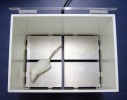Authors
A. Pujol, C. Hindelang, N. Callizot, U. Bartsch, M. Schachner et al.
Lab
Institut de Génétique et de Biologie Moléculaire et Cellulaire, CNRS/INSERM/ULP, ILLKIRCH, France ; Societé Neurofit, ILLKIRCH, France ; Zentrum für Molekulare Neurobiologie, Hamburg, Germany.
Journal
Human Molecular Genetics
Abstract
Adrenomyeloneuropathy (AMN) and cerebral childhood adrenoleukodystrophy (CCALD) are the main phenotypic variants of an X-linked inherited metabolic disorder causing demyelination, X-linked adrenoleukodystrophy (X-ALD). It is caused by mutations in the ABCD1 (ALD) gene encoding a peroxisomal ABC transporter. Inactivation of the murine ALD gene does not lead to a detectable clinical phenotype in mice up to 6 months, and no cerebral pathology resembling the childhood form (CCALD) was observed. In this work, we show that older ALD-deficient mice exhibit an abnormal neurological and behavioral phenotype, starting at around 15 months. This is correlated with slower nerve conduction, and with myelin and axonal anomalies detectable in the spinal cord and sciatic nerve, but not in brain. The phenotype of ALD-deficient mice mimics features of human AMN, thus providing a model for investigating the pathogenesis of this disease.
BIOSEB Instruments Used:
Aron Test or Four Plates Test (LE830),Rotarod (BX-ROD)

 Douleur - Allodynie/Hyperalgésie Thermique
Douleur - Allodynie/Hyperalgésie Thermique Douleur - Spontanée - Déficit de Posture
Douleur - Spontanée - Déficit de Posture Douleur - Allodynie/Hyperalgésie Mécanique
Douleur - Allodynie/Hyperalgésie Mécanique Apprentissage/Mémoire - Attention - Addiction
Apprentissage/Mémoire - Attention - Addiction Physiologie & Recherche Respiratoire
Physiologie & Recherche Respiratoire
 Douleur
Douleur Métabolisme
Métabolisme Système moteur
Système moteur Neurodégénérescence
Neurodégénérescence Thématiques transversales
Thématiques transversales Système musculaire
Système musculaire Functions de motricité générale
Functions de motricité générale Troubles de l'humeur
Troubles de l'humeur Other disorders
Other disorders Joints
Joints Système Nerveux Central (SNC)
Système Nerveux Central (SNC)  Système sensoriel
Système sensoriel

